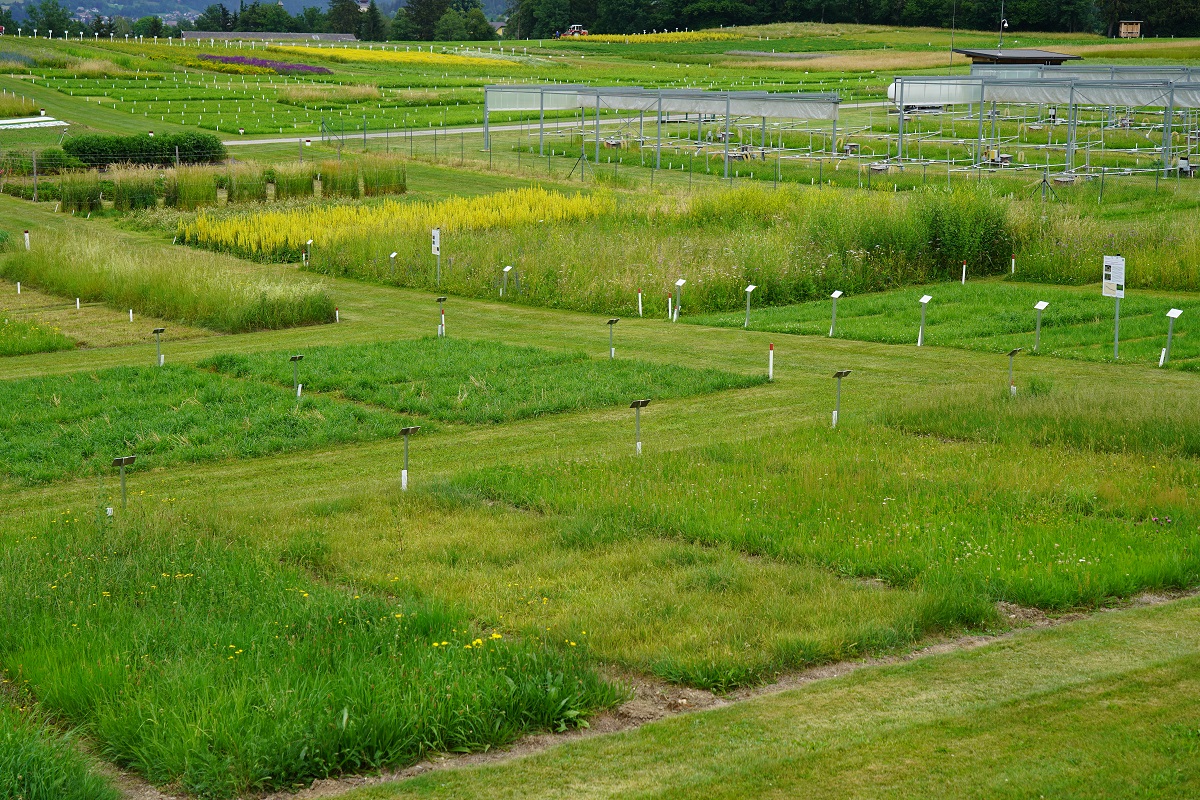After a year of preparatory work, the exhibition and excursion area on the topics of “Soil-Water-Plants” was opened on Wednesday, June 22nd by Dr. Andreas Steinwidder - representing Dir. Johann Gasteiner - and Dr. Bernhard Krautzer, head of the Institute for Plant Production and Cultural Landscape, ceremoniously opened. At a total of eight stations, interested students, farmers and consumers can now get their own idea of the complex interaction between climate, soil, plants and management.
The newly opened cultural exhibition garden clearly shows how diverse grassland can be. The plant population usually consists of a mixture of 15 to 40 different grasses, clovers and herbs - in exceptional cases even more than a hundred different species. “This is always the result of an interaction of a variety of factors,” explains Bernhard Krautzer in his welcoming speech: “An important factor is the climate - i.e. temperature, precipitation and duration of the growing season. The next essential factor is the soil. In the interaction of soil physics, chemical parameters and the water balance, it is the basis of life and also the most important production factor in agriculture. The availability of water and nutrients has a significant impact on root growth and therefore also on the development of the above-ground parts of the plant.”
As part of this new exhibition and excursion area, interested visitors are offered the opportunity to look deep into different soils and watch the roots grow.
The different grassland stocks are also clearly presented. From rich in herbs to grasses, sometimes cut short, sometimes in a state of maturity - when you visit the cultural exhibition garden, everyone can get their own idea of the diversity of the grassland.
Grassland doesn't turn green on its own
At least if you want to optimize forage yields and qualities on such areas. To do this, you need varieties from forage plant breeding that are adapted to the climate, location and management. These just over 20 species with well over 300 varieties must be tested for their suitability under Austrian farming conditions and their mixture composition must also be observed at different locations.
“Of course, there is not just this one type of crop in the grassland area, but also important others such as silage maize, potatoes, grain, to name just a few, which are also used as animal feed or for human nutrition,” the institute director continues.
Loss of biodiversity
However, more intensive use, as is necessary in commercial grassland, is also accompanied by a reduction in biodiversity. Only those species and varieties can survive that can tolerate the nutrient level and intensity of use under the respective location and management conditions. However, plant populations can also be supported by regular reseeding with suitable mixtures.
Biodiversity is important for grassland, so in addition to securing the economic basis of grassland farms for the production of milk and meat, biodiversity must also be preserved and promoted.
There are different options for doing this, but the prerequisite for this is the existence of the desired species spectrum. These types of native wild plants, protected in our gene bank and propagated by farmers, can be put together to form suitable extensive, richly flowering grassland mixtures and thus enrich the cultivated landscape again, with all the positive effects on the development of insects, birds and small game. How grassland offers very important ecosystem services that are essential for us humans - in addition to biodiversity, the provision of high-quality drinking water, oxygen, carbon storage in the soil and ultimately the provision of a richly structured cultural landscape with the highest recreational value.
The scientific staff at the Institute of Plant Production and Cultural Landscapes deal with all of these topics and can now be experienced and explored for yourself - clearly presented and summarized in a compact manner - during a visit to the “Soil-Water-Plants” exhibition and excursion area.
How different fertilization variants affect the composition and yield of the plant population as well as a selection of possible arable crops for the inner Alpine area are shown at the individual stations, as well as the variety of seed mixtures for the cultivation of different grassland locations, or the influence of reseeding and cultivation intensity Yield, feed quality, plant population and water consumption of permanent grassland. The soil - water - root display cellar, in which the soil as a basis of life with all its functions is presented, as well as the globally unique outdoor experiment ClimGrass, where a wide variety of climate scenarios are simulated on a total of 54 test plots, round off the offering.
Registrations are being accepted now and we would be happy to welcome many school classes, farmers and also interested consumers.













